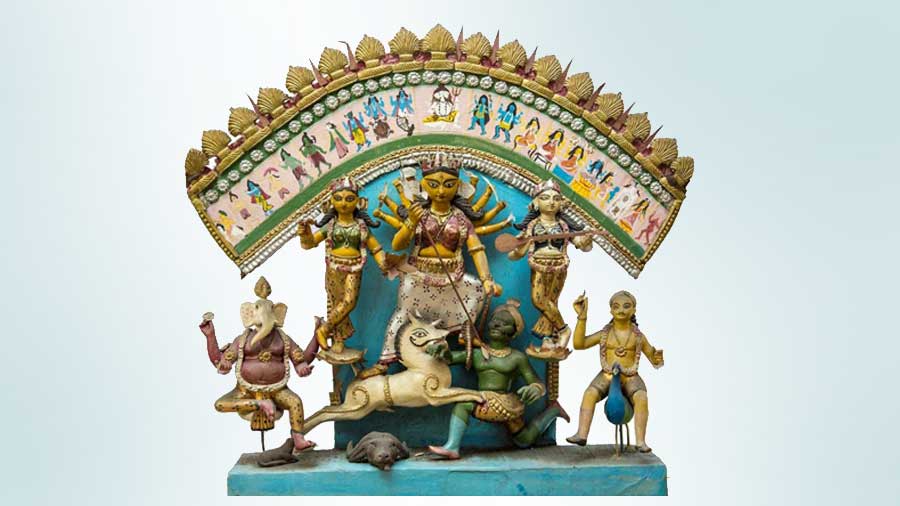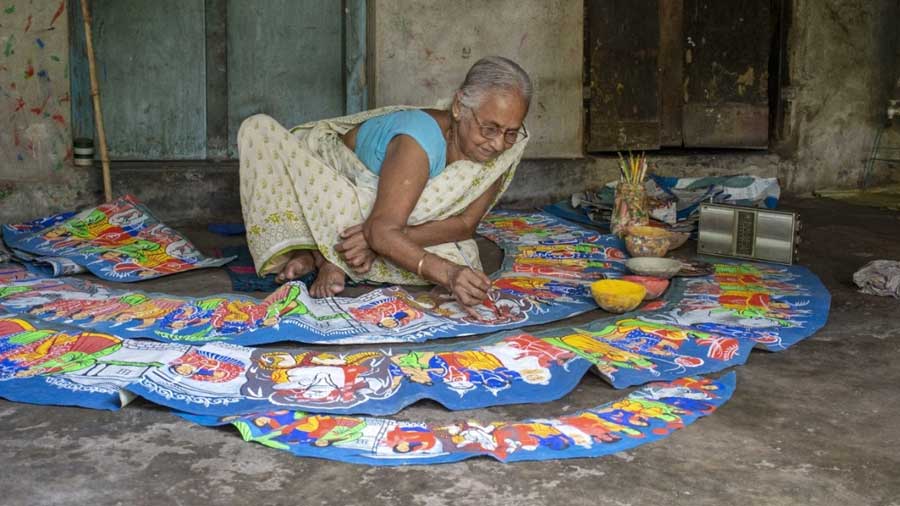“Ashwiner sharad prate beje utheche alok monjir…”
The city woke to the tune of Mahishasurmardini and Debipokkhyo set in on Wednesday. The biggest festival of Bengal commenced today with ‘pitri tarpan’ — signifying that just a few days remain for the Pujas to start in full swing. But, Durga Puja is just not a religious festival — it is also a festival of creativity and craftsmanship.
If Durga idol-making is an art form, then Chalchitro is possibly one of the finest of artworks — and certainly an ignored one. Chalchitra is the circular canvas of paintings behind the idol.
Popularly known as Durga Chal or devi chal, its history dates back at least 300 years. It is an extension of the Patachitra art form of Bengal. Though a lot has been written and discussed about Patachitra, Chalchitra somehow remains neglected.
Though it was prevalent in most parts of Bengal, now it can be found in parts of Nadia — mainly Krishnanagar, Nabadwip, Shantipur and, Ranaghat — Berhampur and Jiaganj of Murshidabad district; Kirnahar, Nanur and Labhpur in Birbhum district, and parts of Bankura.

A miniature Durga idol with a chal, from the collection of educationist and essayist Sudhir Chakraborty Saikat Mukherjee
Chalchitro is typically seen in an ekchala protima (idols which are placed in a single frame). In the age of theme-based pujas, with all the grandeur around it, Chalchitra can now be seen in either some bonedi family’s murti or in household idols — very rarely in barowari pujas.
Chalchitra was created not only to give a balance to the entire idol ensemble, but also to create a certain artistic aesthetic.
Different forms of Chalchitro have been prevalent in different eras. Now we mostly get to see four types of Chalchitra — Bangla Chal, Markini Chal, Mothchouri Chal and Tanatani Chal. Other forms of Chal like Girje Chal, Sorbosundari Chal and Dothaki Chal were also pretty famous, but died out due to the lack of proper artists.
The Chals were named after its shape. The Mothchouri Chal, which has a half moon shape, is divided into four parts and looks like a wave. The Bangla Chal looks like a chalaghor (a thatched house). Similarly, the Tanachouri Chal has three distinct pinnacles.
A typical devi chal has several god and goddess figures, along with mythological characters — though with the variations and details narrowed down. Different characters are drawn in a Chalchitra and various forms have evolved to accommodate them.

A Chalchitro of 'Dashavatar' and 'Ashtosokhi' form Sudhir Chakraborty's collection Saikat Mukherjee
Bengali educationist and essayist Sudhir Chakraborty, in his book Chalchitra, notes that a typical Chalchitra of the present time has two warlike images on both sides — usually with the Devi fighting the demons. In the middle is Mahadev. To fill up the blank spaces, images of Ram and Sita or Krishna’s Vrindavan Leela are often illustrated. Other than this, Brahma, Vishnu, Indra, Narad and Dakkhya are also present. But Chalchitro once had an even wider display of figures like the Dashavatars (ten primary avatars of Vishnu) or the Devi’s Ashtasakhi.
Though the traditional illustrations are now found only in museums or some rajbaris, the art is not yet obsolete. Instead of hand painting, a lot of Chalchitras are now printed and pasted. But there are some artists who are still trying to maintain the tradition.

Reba Pal of Krishnanagar at work Anik Kindu
One of the veterans in this field is Reba Pal of Ghurni, Krishnanagar. Now in her 70s, she has been making Chalchitras for the past 45-50 years. She learnt the art from her husband, Sasthi Pal. After he passed away, she decided to keep the tradition alive.
She creates only one kind of Chal, but sizes can be customised. Starting from the left are images of the Asur-Kali battle, followed by Ram, Laxman and Sita seated on thrones. Next are Brahma, Narad, Narayan, Dakhkha, Mahadev. On the right, Devi Singhabahini is seen fighting followed by the figures of two sakhis, then comes Radha- Krishna, followed again by two sakhis, then Bhagavati and ends again with Mahadev. There could be slight changes in the images but this is the basic template.

A Chalchitro made by Reba Pal
Though she isn’t aware of which puja committees procure her Chalchitras, she knows that a certain portion of her work goes to Kumartuli.
Not only for Durga Puja, she makes Chalchitra for other pujas as well. After cutting the paper and sticking them together, a half-circle shape is formed. On that, she usually puts up colours of the sky on top, mountains in the middle and grass below. After that, images are drawn in different colours. When asked about the future, she spoke about training her son in the art. But like most other people, the pandemic has hit her badly too. Orders have dropped and sizes have become smaller, said the artist.
